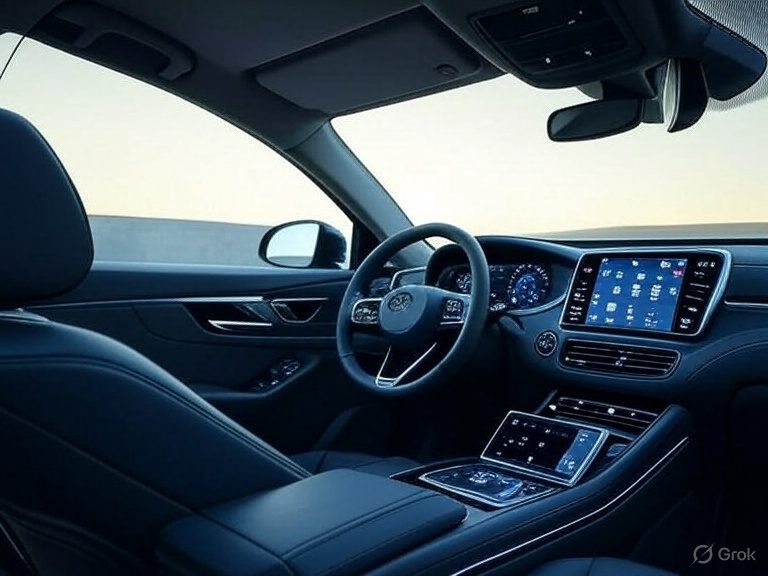Your Car is Watching You: How Driver Monitoring Technology is Making Roads Safer
The Bottom Line: New technology in cars can tell when you’re tired, distracted, or having a medical emergency – and it might just save your life. Here’s what every driver needs to know about these “smart” safety systems.
Imagine your car could tell when you’re about to fall asleep at the wheel, or when you’re too distracted by your phone to notice the traffic ahead. Sound like science fiction? It’s not – this technology is already in some cars today, and it’s coming to many more vehicles soon.
What Exactly is Driver Monitoring Technology?
Think of it as a digital co-pilot that never gets tired. These systems use small cameras (usually mounted near your rearview mirror) and sensors to watch how you drive. They’re looking for warning signs that you might be:- Getting drowsy – tracking how often you blink and if your eyes are staying open
- Distracted – noticing if you’re looking at your phone instead of the road
- Having a medical emergency – detecting sudden changes in your behavior or vital signs
- Impaired – recognizing erratic driving patterns that might indicate you shouldn’t be driving
How Does Your Car “See” You?
The technology might sound complicated, but it’s actually pretty straightforward: Cameras are the main tool. Small cameras use both regular light and infrared (heat vision) to watch your face and eyes, even in the dark. They can track where you’re looking, how often you blink, and if your head is drooping. Smart software does the thinking. The camera feeds information to computer programs that have been “trained” to recognize dangerous patterns. For example, if you’re blinking very slowly or your eyes are closed for more than a few seconds, the system knows you might be falling asleep. Some cars go further. Newer systems can even monitor your heart rate and other vital signs without you wearing anything special – just by analyzing tiny changes the camera can detect.Real-World Impact: Studies show these eye-tracking systems can detect driver fatigue with about 89% accuracy – that’s pretty impressive for a computer watching your face!
What Happens When the System Detects a Problem?
Different cars handle alerts differently, but here’s what you might experience:- Gentle warnings first: A chime, dashboard light, or message saying “Take a break”
- More urgent alerts: Louder sounds, seat vibrations, or flashing lights
- Active intervention: The car might slow down, help keep you in your lane, or even pull over safely
- Emergency response: In serious cases, the system could call 911 automatically
Why This Technology is Spreading Fast
The government is getting involved. While the U.S. doesn’t require these systems yet, Europe does – and American car companies are adding them here too because it’s easier to use the same technology everywhere. Insurance companies love it. Some insurers are starting to offer discounts for cars with driver monitoring systems because they prevent accidents. It’s getting cheaper. What used to be luxury car technology is becoming standard equipment, just like backup cameras did a few years ago.Market Reality: The driver monitoring technology market is expected to double in size over the next 10 years, meaning these systems will become as common as airbags.
What About Your Privacy?
This is probably your biggest concern, and it’s totally understandable. Here’s what you should know:- Most systems don’t record video – they just analyze what they see in real-time
- Data usually stays in your car – it’s not automatically sent to the manufacturer
- You can often turn it off – though you might lose some safety benefits
- Laws are catching up – regulations are being developed to protect your privacy
Real-World Examples You Might Encounter
If you drive for work: Delivery companies, trucking firms, and ride-share services are quickly adopting this technology. Your work vehicle might already have it. If you’re buying a new car: Many 2024 and 2025 models come with some form of driver monitoring, especially in mid-range and luxury vehicles. If you’re a parent: Some systems can send alerts to your phone if they detect risky driving behavior, which could be useful for teen drivers.The Technology is Getting Smarter
Recent advances showcased at tech shows include:- Invisible cameras built into your dashboard display – you won’t even know they’re there
- Health monitoring that can detect heart problems or seizures
- Personalized systems that learn your normal driving patterns and only alert when something’s really wrong
What This Means for You
The good news: This technology has real potential to save lives. Human error causes over 90% of car accidents, and many of those are due to fatigue, distraction, or impairment – exactly what these systems are designed to catch. The reality check: Like any technology, it’s not perfect. The systems can sometimes give false alarms, and they work better for some people than others. Your choice: As this technology becomes more common, you’ll have decisions to make about privacy settings, alert preferences, and whether to use these features at all.Bottom Line: Driver monitoring technology is here to stay, and it’s getting better fast. While it raises some privacy questions, the safety benefits are real. The key is understanding how it works so you can make informed decisions about the technology in your car.
Looking Ahead
In the next few years, expect to see:- These systems in most new cars, not just expensive ones
- Better integration with your smartphone and other devices
- More personalized alerts that learn your driving habits
- Possible insurance discounts for cars equipped with this technology
Stay Safe. Stay Compliant. Choose Traffic Safety Store.

